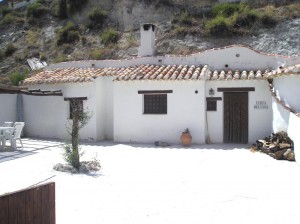 On the A92 between Granada and Almeria you'll come across Guadix, which is famous for the Jarra Accittanas. These ornate terracotta vases are used for wedding guests to carry their gifts for the bride and groom (no-one ever receives a TV for a wedding present in Guadix). Despite this unusual tradition and the pretty streets and buildings, the town is better known for its cave houses.
On the A92 between Granada and Almeria you'll come across Guadix, which is famous for the Jarra Accittanas. These ornate terracotta vases are used for wedding guests to carry their gifts for the bride and groom (no-one ever receives a TV for a wedding present in Guadix). Despite this unusual tradition and the pretty streets and buildings, the town is better known for its cave houses.
You can find 'La Barriada de Las Cuevas' in the north of the town, and as you're walking around you half expect to see Barney Rubble leaving one of the small front doors, ready for a hard day at the quarry. The small frontage of the houses and the white square chimneys would lead one to believe that the homes are tiny, but think Tardis. The interiors can be quite large, some are even hotels. One great advantage of the cave houses is the year-round constant temperature of a much civilised 20 degrees centigrade, and when it's 40 degrees outside, you can begin to see the attraction. There are in fact around four thousand caves that form biggest inhabited cave settlement in Europe. Half the population of Guadix are Troglodytes.
Guadix itself has been around a long, long time. Julius Caesar instigated the building of a settlement in order to mine the silver from the nearby hills, but it was the Moors who created the cave settlement. Before that, they developed an important silk industry, which put the town on a par with Granada, but in the fifteenth century they were expelled by the Christians and had no choice but to retreat to the hills and live in existing caves, or dig new ones. The ground in this area is easily excavated, so it was a natural thing to do, rather than brave the harsh outdoor elements. The name Guadix stems from the Arabic 'Guadh-Haix', which means 'River of Life' and the town was once an important centre of art and poetry. The cave museum is situated in the centre of Guadix, and is well worth a visit. Also of interest is the Cathedral which dates back to the sixteenth century. The Alcazabar, which was built in the eleventh century, is the best example of Moorish construction in the area, and from its towers a breathtaking view of the Sierra Nevadas is afforded.
Just down the road is the castle of Calahorra, which was awarded to a Christian knight as a reward for his deeds during the Christian re-conquest. It boasts an impressive courtyard made from Italian marble, which was constructed by Florentine craftsmen. Approaching the castle, you can't help but be moved by the sight of the round towers standing proudly against the Sierra Nevada mountains. Another impressive place to add to your list is the desert landscape around Benalua de Guadix. Combine this with a visit to the Banos de Las Alicun de Las Torres, and you have a fantastic day out right on the doorstep.
Fiestas play a big part of Guadix life, the main one falling on the weekend before Ash Wednesday. The summer fair takes place in the first week of September. In January the 'Romeria de San Anton takes place, when pilgrims ride nine times around the town on horseback. The Bishop gives mass on San Torcuato's day in May, before the remains of the saint are paraded through the town. Of course, Semana Santa is a very important time here, as it is throughout the whole of Spain, so there's a very good chance that your visit to Guadix will coincide with a fiesta.
Getting to Guadix couldn't be easier. The mountain tracks have been replaced by modern motorways which link the town to other important centres such as Almeria, Granada and Malaga. There are international airports in both Malaga and Granada which have numerous incoming flights from Britain and the rest of Europe, so if you're looking for something just that bit different, renting a cave house could be right up your street. Many visitors take a day off from the beaches of the Costa del Sol and Costa Tropical to soak up the atmosphere of the Troglodyte village. The inhabitants of the cave houses are renowned for their friendliness and hospitality, probably because they're so cool while everyone else is steaming.